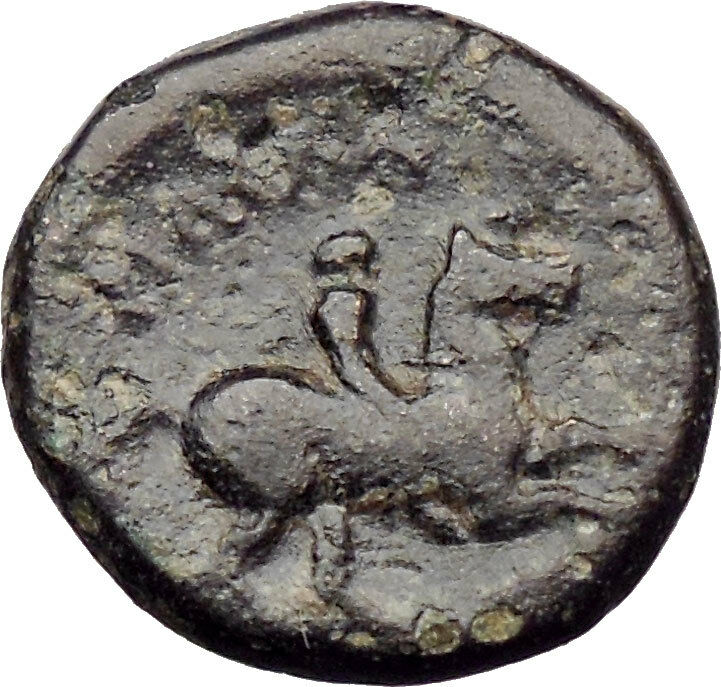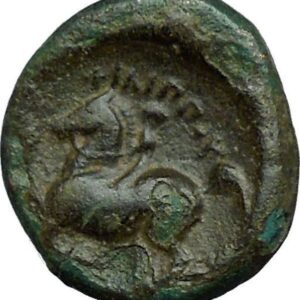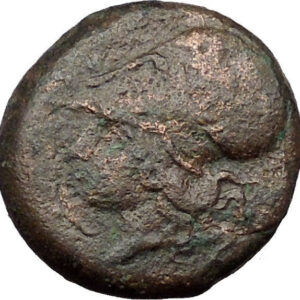|
Lokris Opuntia Federal Coinage
Ostensibly Struck at Greek city of Opus in Lokris
Bronze 16mm (2.44 grams) Struck circa 369-338 B.C.
Head of Persephone right.
OΠΟNTIΩN, Ajax, son of Oileus, naked but for helmet, advancing right, holding sword and large shield decorated with serpent.
A mountainous and infertile region of Central Greece, Phokis began producing a federal currency in early part of the 5th Century B.C. There were two separate districts occupied by the Lokrians – eastern Lokris, opposite the coastlines of Thessaly and Euboia, inhabited by the Opuntians and the Epiknemidians; the western Lokris, on the Corinthian gulf, called Lokris Ozolis. Following the battle of Chaeroneia, 338 B.C. , the coins were issued in the name of the Lokrians in general, rather than just the Opuntians, though doubtless Opus remained the mint.
The Opuntian Lokris enjoyed fame for being the home of Ajax the Lesser. This took forty ships to fight at Troy, however was later killed by Poseidon and Athena because of sacrilege and hubris after the city fell. When the Lokrians marched off to war, they reserved a space for the shadow of Ajax in their phalanx.
You are bidding on the exact item pictured, provided with a Certificate of Authenticity and Lifetime Guarantee of Authenticity.
In Greek mythology, Persephone, also called Kore or Cora (/ˈkɔəriː/; “the maiden”), is the daughter of Zeus and the harvest goddess Demeter, and is the queen of the underworld. Homer describes her as the formidable, venerable majestic princess of the underworld, who carries into effect the curses of men upon the souls of the dead. Persephone was abducted by Hades, the god-king of the underworld. The myth of her abduction represents her function as the personification of vegetation, which shoots forth in spring and withdraws into the earth after harvest; hence, she is also associated with spring as well as the fertility of vegetation. Similar myths appear in the Orient, in the cults of male gods like Attis, Adonis and Osiris, and in Minoan Crete.
Persephone as a vegetation goddess and her mother Demeter were the central figures of the Eleusinian mysteries that predated the Olympian pantheon and promised the initiated a more enjoyable prospect after death. Persephone is further said to have become by Zeus the mother of Dionysus, Iacchus, or Zagreus, usually in orphic tradition. The origins of her cult are uncertain, but it was based on very old agrarian cults of agricultural communities.
Persephone was commonly worshipped along with Demeter and with the same mysteries. To her alone were dedicated the mysteries celebrated at Athens in the month of Anthesterion. In Classical Greek art, Persephone is invariably portrayed robed, often carrying a sheaf of grain. She may appear as a mystical divinity with a sceptre and a little box, but she was mostly represented in the act of being carried off by Hades.
In Roman mythology, she is called Proserpina, and her mother, Ceres.
Ajax (Ancient Greek: Αἴας) was a Greek mythological hero, son of Oileus, the king of Locris. He was called the “lesser” or “Locrian” Ajax, to distinguish him from Ajax the Great, son of Telamon. He was the leader of the Locrian contingent during the Trojan War. He is a significant figure in Homer’s Iliad and is also mentioned in the Odyssey and Virgil’s Aeneid. In Etruscan legend, he was known as Aivas Vilates.
Mythology
His mother’s name was Eriopis. According to Strabo, he was born in Naryx in Locris, where Ovid calls him Narycius Heroes. According to the Iliad, he led his Locrians in forty ships against Troy. He is described as one of the great heroes among the Greeks. When the grammatical dual form of Ajax is used in the Iliad, it was once believed that it indicated the lesser Ajax fighting side-by-side with Telamonian Ajax, but now it is generally thought that that usage refers to the Greater Ajax and his brother Teucer. In battle, he wore a linen cuirass (λιμνοθώρηξ), was brave and intrepid, especially skilled in throwing the spear and, next to Achilles, the swiftest of all the Greeks.
Ajax the Lesser raping Cassandra
In the funeral games at the pyre of Patroclus, he contended with Odysseus and Antilochus for the prize in the footrace; but Athena, who was hostile towards him and favored Odysseus, made him stumble and fall, so that he won only the second prize. On his return from Troy, his vessel was wrecked on the Whirling Rocks (Γυραὶ πέτραι), but he himself escaped upon a rock through the assistance of Poseidon and would have been saved in spite of Athena, but he said that he would escape the dangers of the sea in defiance of the immortals. In punishment for this presumption, Poseidon split the rock with his trident and Ajax was swallowed up by the sea.
In later traditions, this Ajax is called a son of Oileus and the nymph Rhene and is also mentioned among the suitors of Helen. After the taking of Troy, it is said he rushed into the temple of Athena, where Cassandra had taken refuge, and was embracing the statue of the goddess in supplication. Ajax violently dragged her away to the other captives. According to some writers, he even raped Cassandra inside the temple. Odysseus, at least, accused him of this crime and Ajax was to be stoned to death, but saved himself by establishing his innocence with an oath. The whole charge was sometimes said to have been an invention of Agamemnon, who wanted to have Cassandra for himself.
Death
 Poseidon killing Ajax the Lesser Poseidon killing Ajax the Lesser
Whether true or not, Athena still had cause to be indignant, as Ajax had dragged a supplicant from her temple. According to the Bibliotheca, no one had realized that Ajax had raped Cassandra until Calchas, the Greek seer, warned the Greeks that Athena was furious at the treatment of her priestess and she would destroy the Greek ships if they didn’t kill him immediately. Despite this, Ajax managed to hide in the altar of an unnamed deity where the Greeks, fearing divine retribution should they kill him and destroy the altar, allowed him to live. When the Greeks left without killing Ajax, despite their sacrifices Athena became so angry that she persuaded Zeus to send a storm that sank many of their ships. When Ajax finally left Troy, Athena hit his ship with a thunderbolt, but Ajax still survived, managing to cling onto a rock. He boasted that even the gods could not kill him and Poseidon, upon hearing this, split the rock with his trident, causing Ajax to eventually drown. Thetis buried him when the corpse washed up on Myconos. Other versions depict a different death for Ajax, showing him dying when on his voyage home. In these versions, when Ajax came to the Capharean Rocks on the coast of Euboea, his ship was wrecked in a fierce storm, he himself was lifted up in a whirlwind and impaled with a flash of rapid fire from Athena in his chest, and his body thrust upon sharp rocks, which afterwards were called the rocks of Ajax.
After his death his spirit dwelt in the island of Leuce. The Opuntian Locrians worshiped Ajax as their national hero, and so great was their faith in him that when they drew up their army in battle, they always left one place open for him, believing that, although invisible to them, he was fighting for and among them. The story of Ajax was frequently made use of by ancient poets and artists, and the hero who appears on some Locrian coins with the helmet, shield, and sword is probably this Ajax.
Other accounts of his death are offered by Philostratus and the scholiast on Lycophron.
Opuntian Locris or Eastern Locris was an ancient Greek region inhabited by the eastern division of the Locrians, the so-called tribe of the Locri Epicnemidii (Greek: Λοκροί Ἐπικνημίδιοι) or Locri Opuntii (Greek: Λοκροί Ὀπούντιοι).
Geography
Opuntian Locris consisted of a narrow slip upon the eastern coast of Greece, from the pass of Thermopylae to the mouth of the river Cephissus. The northern frontier town was Alpeni, which bordered upon the Malians, and the southern frontier town was Larymna, which at a later time belonged to Boeotia. The Locrians, however, did not inhabit this coast continuously, but were separated by a narrow slip of Phocis, which extended to the Euboean sea, and contained the Phocian seaport town of Daphnus. The Locrians north of Daphnus were called Epicnemidii, from Mount Cnemis; and those south of this town were named Opuntii, from Opus, their principal city. On the west the Locrians were separated from Phocis and Boeotia by a range of mountains, extending from Mount Oeta and running parallel to the coast. The northern part of this range, called Mount Cnemis, now Tálanda, rises to a considerable height, and separated the Epicnemidii Locri from the Phocians of the upper valley of the Cephissus; the southern portion, which bore no specific name, is not so lofty as Mount Cnemis, and separated the Opuntian Locrians from the north-eastern parts of Boeotia. Lateral branches extended from these mountains to the coast, of which one terminated in the promontory Cnemides, opposite the islands called Lichades; but there were several fruitful valleys, and the fertility of the whole of the Locrian coast is praised both by ancient and modern observers. In consequence of the proximity of the mountains to the coast there was no room for any considerable rivers. The largest, which, however, is only a mountain torrent, is the Boagrius (Βοάγριος), called also Manes (Μάνης) by Strabo, rising in Mount Cnemis, and flowing into the sea between Scarpheia and Thronium. The only other river mentioned by name is the Platanius, a small stream, which flows into the Opuntian gulf near the Boeotian frontier: it is the river which flows from the modern village of Prosklyná.
Opuntian Gulf
The Opuntian Gulf, at the head of which stood the town of Opus, is a considerable bay, shallow at its inner extremity. In this bay, close to the coast, is the small island of Atalanta.
History
The Eastern Locrians, are mentioned by Homer, who describes them as following Ajax, the son of Oïleus, to the Trojan War in forty ships, and as inhabiting the towns of Cynus, Opus, Calliarus, Besa, Scarphe, Augeiae, Tarphe, and Thronium. Neither Homer, Herodotus, Thucydides, nor Polybius, make any distinction between the Opuntii and Epicnemidii; and, during the flourishing period of Greek history, Opus was regarded as the chief town of the Eastern Locrians. Even Strabo, from whom the distinction is chiefly derived, in one place describes Opus as the metropolis of the Epicnemidii (ix. p. 416); and the same is confirmed by Pliny (iv. 7. s. 12) and Stephanus. In the Persian War the Opuntian Locrians fought with Leonidas at the Battle of Thermopylae, and also sent seven ships to the Greek fleet. The Locrians fought on the side of Sparta in the Peloponnesian War. The Locri Opuntii also minted coins in antiquity, some of which survive.
Cities and towns
The cities and towns of the Locri Epicnemidii, along the coast from north to south, were: Alpenus, Nicaea, Scarphe (Scarpheia), Thronium, Cnemis (Cnemides), more inland, Tarphe later Pharygae, and Augeiae. The cities and towns of the Locri Opuntii, along the coast from north to south, were: Alope, Cynus, Opus, Halae, Larymna which later belonged to Boeotia, more inland, Calliarus, Naryx, and Corseia.
|






 Poseidon killing Ajax the Lesser
Poseidon killing Ajax the Lesser




